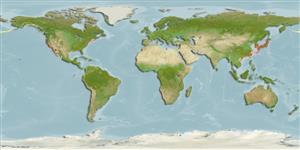Not assigned |
Sipuncula |
Golfingiidae
Environment: milieu / climate zone / εύρος βάθους / distribution range
Οικολογία
; εύρος βάθους 0 - 36 m (Αναφ. 1815). Temperate
Western Central Atlantic and the Pacific Ocean: Alaska, Japan, Mexico and USA.
Length at first maturity / Μέγεθος / Weight / Age
Γεννητική Ωρίμανση: Lm ? range ? - ? cm
Large animals, brownish-yellow to dark brown in color. Body 0.1-0.6 mm long. Trunk spindle shaped or cylindrical. Introvert significantly longer than trunk. Body surface smooth-seeming, as papillae covering it very small. Cephalon bearing dendritic crown of tentacles, consisting of 6 main dichotomic branching trunks. Number of orders of branching characteristic
of every particular specimen (from 4-7). Branches of tentacles bearing pinnules with
purple pigmented grains. Smooth collar behind tentacles, tentacles,
with violet patchy pigmentation. Zone of irregularly arranged large scalids behind cephalon. Longitudinal musculature of body wall not divided into longitudinal bands, instead forming solid layer. 2 retractors of introvert, both ventral and fastened into posterior third of trunk. Contractile vessel with long, filiform, spirally twisted branches braiding internal organs. Gut long, comprising 16-20 loops. 3 fixing muscles. Anal opening level with nephridiopores. Wing
muscles well-developed. No rectal diverticulum found. 2 nephridia partially fastened to body wall by mesenterial filaments. Nephridia 80% as long as trunk region (Ref. 1815).
At intertidal depths in crevices and spaces under rocks (Ref. 1840). Among rhizomes of Phyllospadix iwatensis and clusters of Modiolus modiolus kurilensis on rocky grounds (Ref. 1815). At intertidal depths from crevices in and spaces under rocks (Ref. 1840, page 152).
Life cycle and mating behavior
Γεννητική Ωρίμανση | Αναπαραγωγή | Γεννοβολία | Eggs | Γονιμότητα | Larvae
Morozov, T.B. and A.V. Adrianov 2002 Fauna of Sipunculans (Sipuncula) of Vostok Bay, Sea of Japan. Russian Journal of Marine Biology 28(6):365-370. (Αναφ. 1815)
IUCN Red List Status
(Αναφ. 130435: Version 2025-1)
CITES status (Αναφ. 108899)
Not Evaluated
Not Evaluated
Threat to humans
Human uses
| FishSource |
Εργαλεία
Περισσότερες πληροφορίες
Τροφική ΟικολογίαFood items (preys)
Σύσταση δίαιτας
Κατανάλωση τροφής
Θηρευτές
Population dynamicsΑύξησηMax. ages / sizesLength-weight rel.Length-length rel.Length-frequenciesMass conversionΑφθονία Life cycleΑναπαραγωγή
Γεννητική Ωρίμανση
Γονιμότητα
Γεννοβολία
Eggs
Egg development
Larvae
PhysiologyΚατανάλωση οξυγόνου
Human RelatedStamps, coins, misc.
Διαδικτυακές πηγές
Estimates based on models
Preferred temperature
(Ref.
115969): 11.4 - 24.8, mean 22.3 (based on 363 cells).
Price category
Unknown.
